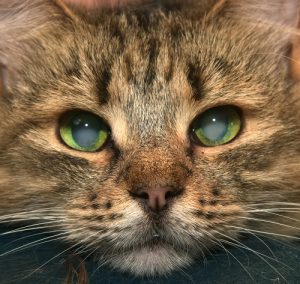A cataract is an opacity or a clouding of the lens of the eye. Cataracts are variable in size. Over time, cataracts cause loss of vision and eventually blindness.
Cataracts in cats are commonly associated with inflammation of the eye, called uveitis. Unlike dogs, surgery is performed less often. Your cat’s eyes should be checked by a vet if they are becoming cloudy.
Overview
What are cataracts and how do they develop?
- Inside the eye, there is a lens that focuses light on the back of the eye (retina).
- Vision occurs at the retina.
- The lens should be crystal clear.
- Diseases of the lens, like cataracts, can change its transparency or clarity.
- A cloudy or opaque lens is called a cataract.
- The most common causes are uveitis and ageing.
- Other causes are genetics, trauma, and diabetes mellitus.
- There are different degrees of severity, depending on how much of the lens is affected. Varying from too small to interfere with vision, to so large that impairs vision.
- A cataract can be classified as either incipient, immature, mature, or hypermature, according to its severity.

- Cataract in a cat
Symptoms
What are the signs of cataracts in cats?
Symptoms of cataracts in cats include:
- Cloudy or foggy eye
- Red eye
- Bumping into things
- Less agile
- Less active
Risk
Do some cats have a higher risk of cataracts than others?
- Cats who suffer from uveitis
- Older cats
- Certain breeds: Russian blue and Bengal
Diagnosis
How are cataracts diagnosed?
Your vet will examine your cat’s eyes and use a light source to check for cataracts and determine their stage.
To help rule out other conditions, your vet may recommend the following:
- Testing the pressure inside the eye
- Dye test
To check for other illnesses affecting the body and the eyes
- Blood tests
- FeLV/FIV status
- Radiographs (x rays)
- Ultrasound scans of the abdomen
- Blood pressure
Vet treatment
How can cataracts be treated?
- The treatment will depend on the cause of the cataract.
- In cats, cataracts are more commonly associated with uveitis, so treatment is usually a combination of oral anti-inflammatories and topical steroids.
- Other treatments may be recommended depending on the clinical signs and underlying problems of the eye.
- The outcome of this is usually good with medical treatment.
- Surgery, like eye enucleation (removal of the eye), may be advised in severe cases such as uncontrollable glaucoma.
Cats with uveitis or glaucoma should be referred to an ophthalmology specialist at an early stage of the disease to maximise the chances of a successful outcome.
Home treatment
How to help a cat with cataracts at home
- A cat with cataracts or vision loss usually adapts well to the environment at home.
- It is important to give blind cats special attention, especially around hazards such as stairs.
- If you have a blind cat, you should avoid moving furniture or any of your cat’s belongings, such as their food dish, water bowl, bed, or litter trays.
- Your cat should be handled with care when meeting a new human or animal.
Prevention
How can you help preserve your cat’s vision
In most cases, you cannot prevent cataracts, but there are ways to ensure that your cat’s vision is preserved, especially if a medical condition like uveitis causes it.
- Check your cat’s eyes regularly.
- Take your cat to the vet if their eyes start to look cloudy.
- Take your cat to the vet if you suspect they’re having trouble seeing.
When to worry
When do you need to call a vet if your cat has cataracts?
When do you need to call a vet?
- Sudden inability to see
- Squinting
- Redness of the eye
- Reluctant to open the affected eye or pawing at the face
- Not improving despite treatment
Call a Joii vet if you need help:
- With your blind cat
- With giving medication








